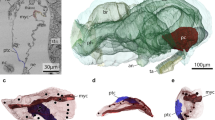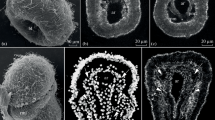Abstract
The origin of mesoderm and coelomic compartments has traditionally been given high value for phylogenetic considerations of animal relationships. Two main modes have been distinguished, associated with the two main groups of animals: schizocoely with protostomes and enterocoely with deuterostomes. During enterocoely, coelomic compartments are formed from the endoderm. Here, we show that the pericardium of the deuterostome Saccoglossus kowalevskii, an enteropneust, is ontogenetically derived from the ectoderm and develops by schizocoely. The pericardium develops from a solid cluster of epidermis cells situated underneath the ectodermal nerve net above the basement membrane of the epidermis. The undifferentiated cells are interconnected by spot desmosomes, become separated from the epidermis and develop a central cavity. Pericardial cells become epithelial, by developing apical adherens junctions, a single apical cilium and basal striated myofibres. The differentiated pericardium possesses a cavity and surrounds a central blood vessel, the heart, situated in the basal extracellular matrix. The pericardium is an integral part of the anterior excretory complex, and comparisons to other deuterostomes indicate that pericardia are homologous despite differing ontogenies. Original data generated for the present study are deposited on MorphDBase (http:\\www.morphdbase.de).






Similar content being viewed by others
References
Anderson K (1907) Die Pterobranchier der schwedischen Südpolar-Expedition 1901–1903. Wissenschaftliche Ergebnisse der schwedischen Südpolarexpedition 5:1–122
Balavoine G, de Rosa R, Adoutte A (2001) Hox clusters and bilaterian phylogeny. Mol Phylogen Evol 24:366–373
Bartolomaeus T (1993) Die Leibeshöhlenverhältnisse und Verwandtschaftsbeziehungen der Spiralia. Habilitationsschrift Fachbereich Biologie. Georg-August-Universität Göttingen, Göttingen, p 301
Bartolomaeus T, Quast B, Koch M (2009) Nephridial development and body cavity formation in Artemia salina (Crustacea: Branchiopoda): no evidence for any transitory coelom. Zoomorphology 128:247–262
Bateson W (1885) The later stages in the development of Balanoglossus kowalevskyi, with a suggestion on the affinities of the Enteropneusta. Q J Microsc Sci 25:81
Benito J, Pardos F (1997) Hemichordata. In: Harrison FW, Ruppert EE (eds) Microscopic anatomy of invertebrates, vol 15. Wiley-Liss, New York, Chichester, Weinheim, Brisbane, Singapore, Toronto, pp 15–101
Cameron CB (2005) A phylogeny of the hemichordates based on morphological characters. Can J Zool 83:196–215
Dawydoff C (1907) Sur la morphologie des formations cardio-péricardique des Enteropneusts. Zool Anz 31:352–362
de Pinna MCC (1991) Concepts and tests of homology in the cladistic paradigm. Cladistics 7:367–394
Dunn CW, Hejnol A, Matus DQ, Pang K, Browne WE, Smith SA, Seaver E, Rouse GW, Obst M, Edgecombe GD, Sorensen MV, Haddock SHD, Schmidt-Rhaesa A, Okusu A, Kristensen RM, Wheeler WC, Martindale MQ, Giribet G (2008) Broad phylogenomic sampling improves resolution of the animal tree of life. Nature 452:745–749
Gemmill JF (1912) I. The development of the starfish Solaster endeca Forbes. Trans Zool Soc Lond 20:1–71
Gemmill JF (1914) The development and certain points in the adult structure of the starfish Asterias rubens, L. Philos Trans R Soc Lond B 205:213–294
Halanych KM (2004) The new view of animal phylogeny. Annu Rev Ecol Syst 35:229–256
Hall BK (2003) Descent with modification: the unity underlying homology and homoplasy as seen through an analysis of development and evolution. Biol Rev 78:409–433
Heider K (1909) Zur Entwicklung von Balanoglossus clavigerus Delle Chiaje. Zool Anz 34:695–704
Hertwig O, Hertwig R (1881) Die Coelomtheorie. Versuch einer Erklärung des mittleren Keimblattes. Gustav Fischer Verlag, Jena
Holland ND, Holland LZ (2010) Laboratory spawning and development of the Bahama Lancelet, Asymmetron lucayanum (Cephalochordata): fertilization through feeding larvae. Biol Bull 219:132–141
Hyman LH (1959) The invertebrates: smaller coelomate groups. McGraw-Hill Book Company, Inc, New York, London, Toronto
Jenner RA (2001) Bilaterian phylogeny and uncritical recycling of morphological data sets. Syst Biol 50:730–742
Jenner RA (2004) Towards a phylogeny of the Metazoa: evaluating alternative phylogenetic positions of Platyhelminthes, Nemertea, and Gnathostomulida, with a critical reappraisal of cladistic characters. Contrib Zool 73:3–163
Jenner RA (2006) Challenging received wisdomes: some contributions of the new microscopy to the new animal phylogeny. Integr Comp Biol 46:93–103
John CC (1932) On the development of Cephalodiscus, vol 6. ‘Discovery’ report, pp 193–204
Kaul S, Stach T (2010) Ontogeny of the collar cord: neurulation in the hemichordate Saccoglossus kowalevskii. J Morph 271:1240–1259
Kugler J, Kerner P, Bouquet J-M, Jiang D, Di Gregorio A (2011) Evolutionary changes in the notochord genetic toolkit: a comparative analysis of notochord genes in the ascidian Ciona and the larvacean Oikopleura. BMC Evol Biol 11:21
Lemaire P, Smith WC, Nishida H (2008) Ascidians and the plasticity of the chordate developmental program. Curr Biol 18:R620–R631
Lester SM (1988) Ultrastructure of adult gonads and development and structure of the larva of Rhabdopleura normani (Hemichordata: Pterobranchia). Acta Zoologica 69:95–109
Lowe C, Tagawa K, Humphreys T, Kirschner M, Gerhart J (2004) Hemichordate embryos: procurement, culture, and basic methods. Methods Cell Biol 74:171–194
Lüter C (2000) The origin of the coelom in Brachiopoda and its phylogenetic significance. Zoomorphology 120:15–28
MacBride EW (1896) The development of Asterina gibbosa. Q J Microsc Sci 38:339–411
Masterman AT (1898) On the theory of archimeric segmentation and its bearing upon the phyletic classification of the Coelomata. Proc R Soc Edinburgh 22:270–310
Mayer G, Bartolomaeus T (2003) Ultrastructure of the stomochord and the heart-glomerulus complex in Rhabdopleura compacta (Pterobranchia): phylogenetic implications. Zoomorphology 122:125–133
Morgan TH (1891) The growth and metamorphosis of Tornaria. J Morphol 5:407–458
Morgan TH (1894) The development of Balanoglossus. J Morphol 9:1–86
Narasimhamurti N (1932) The development and function of the heart and pericardium in Echinodermata. Proc R Soc B Biol Sci 109:471–487
Nielsen C (2001) Animal evolution. Interrelationships of the living phyla. Oxford University Press, New York, Tokyo
Nielsen C, Scharff N, Eibye-Jacobsen D (1996) Cladistic analysis of the animal kingdom. Biol J Linn Soc 57:385–410
Peterson KJ, Eernisse DJ (2001) Animal phylogeny and the ancestry of bilaterians: inferences from morphology and 18S rDNA sequences. Evol Dev 3:170–205
Philip GK, Creevey CJ, McInerney JO (2005) The Opisthokonta and the Ecdysozoa may not be Clades: stronger support for the grouping of plant and animal than for animal and fungi and stronger support for the Coelomata than Ecdysozoa. Mol Biol Evol 22:1175–1184
Rao KP (1953) The development of Glandiceps (Enteropneusta; Spengelidae). J Morphol 93:1–17
Remane A (1950) Entstehung der Metamerie der Wirbellosen. Zool Anz 14:16–23
Rieger RM, Lombardi J (1987) Ultrastructure of the coelomic lining in echinoderm podia: significance for concepts in the evolution of muscle and peritoneal cells. Zoomorphology 107:191–208
Rogozin IB, Wolf YI, Carmel L, Koonin EV (2007) Analysis of rare amino acid replacements supports the Coelomata clade. Mol Biol Evol 24:2594–2597
Roy SW, Irimia M (2008) Rare genomic characters do not support Coelomata: RGC CAMs. J Mol Evol 66:308–315
Ruppert EE (1991) Introduction to the aschelminth phyla: a consideration of mesoderm, body cavities, and cuticle. In: Harrison FW (ed) Microscopic anatomy of invertebrates. Wiley-Liss, Inc, New York
Ruppert EE, Balser EJ (1986) Nephridia in the larvae of hemichordates and echinoderms. Biol Bull 171:188–196
Schierwater B, Eitel M, Jakob W, Osigus H-J, Hadrys H, Dellaporta SL, Kolokotronis S-O, DeSalle R (2009) Concatenated analysis sheds light on early metazoan evolution and fuels a modern “Urmetazoon’ hypothesis. PLoS Biol 7:e1000020
Scholtz G (2010) Deconstructing morphology. Acta Zoologica 91:44–63
Scotland RW, Olmstead RG, Bennett JR (2003) Phylogeny reconstruction: the role of morphology. Syst Biol 52:539–548
Spengel JW (1893) Die Enteropneusten des Golfes von Neapel und der angrenzenden Meeres-Abschnitte. Fauna und Flora des Golfes von Neapel, vol 18. Engelmann, Leipzig
Stach T (1996) On the preoral pit of the larval amphioxus (Branchiostoma lanceolatum). Annales des Sci naturelles, Zoologie, Paris 17:129–134
Stach T (2000) Microscopic anatomy of developmental stages of Branchiostoma lanceolatum (Cephalochordata, Chordata). Bonn Zool Monogr 47:1–111
Stach T (2002) Minireview: on the homology of the protocoel in Cephalochordata and ‘lower’ Deuterostomia. Acta Zoologica 83:25–31
Stach T, Kaul S (2011) The postanal tail of the enteropneust Saccoglossus kowalevskii is a ciliarly creeping organ without distinct similarities to the chordate tail. A Zool 92:150–160
Stiasny G (1914) Studium über die Entwicklung des Balanoglossus clavigerus Delle Chiaje. II. Darstellung der weiteren Entwicklung bis zur Metamorphose. Mittheilungen aus der zoologischen Station Neapel 22:255–290
Swalla BJ, Smith AB (2008) Deciphering deuterostome phylogeny: molecular, morphological and palaeontological perspectives. Philos Trans R Soc Lond B 363:1557–1568
Technau U, Scholz CB (2003) Origin and evolution of endoderm and mesoderm. Int J Dev Biol 47:531–539
Telford MJ (2004) Animal phylogeny: back to the Coelomata? Curr Biol 14:R274–R276
Valentine JW (1973) Coelomate superphyla. Syst Zool 22:97–102
von Ubisch L (1913) Die Entwicklung von Strongylocentrotus lividus (Echinus microtuberculatus, Arbacia pustulosa). Zeitschrift für wissenschaftliche Zoologie 106:409–448, plates 405–407
Wilson BB (1895) The embryological criterion of homology. Biological Lectures of the Marine Biological Laboratory, Woods Hole 3:101–124
Acknowledgments
We would like to thank Prof. Dr. Chris Lowe (Stanford University) for the invaluable help in collecting the animals on which this study was based. O. Schröder is thanked for additional sectioning. This study was supported by grants of the German Research Foundation (Deutsche Forschungsgemeinschaft, DFG).
Author information
Authors and Affiliations
Corresponding author
Additional information
Communicated by T. Bartolomaeus.
Rights and permissions
About this article
Cite this article
Kaul-Strehlow, S., Stach, T. The pericardium in the deuterostome Saccoglossus kowalevskii (Enteropneusta) develops from the ectoderm via schizocoely. Zoomorphology 130, 107–120 (2011). https://doi.org/10.1007/s00435-011-0125-0
Received:
Revised:
Accepted:
Published:
Issue Date:
DOI: https://doi.org/10.1007/s00435-011-0125-0




